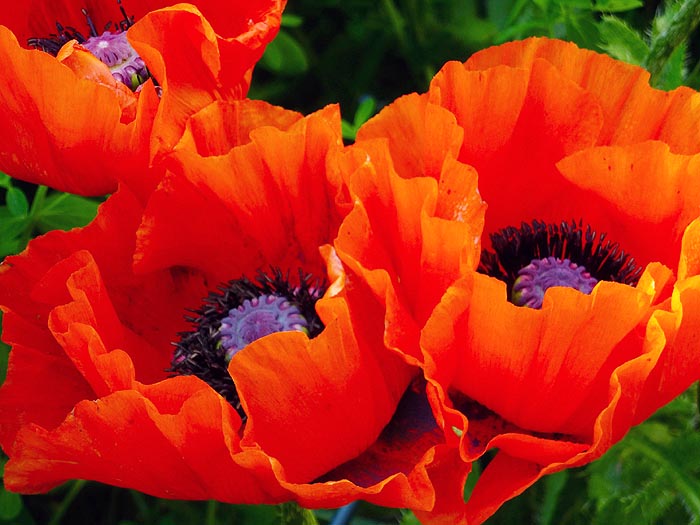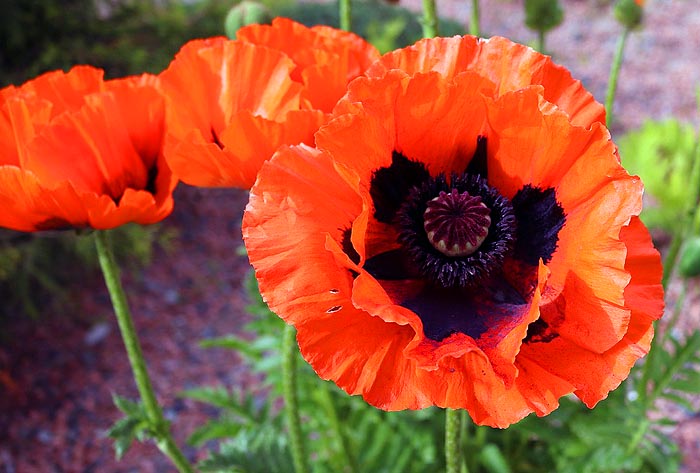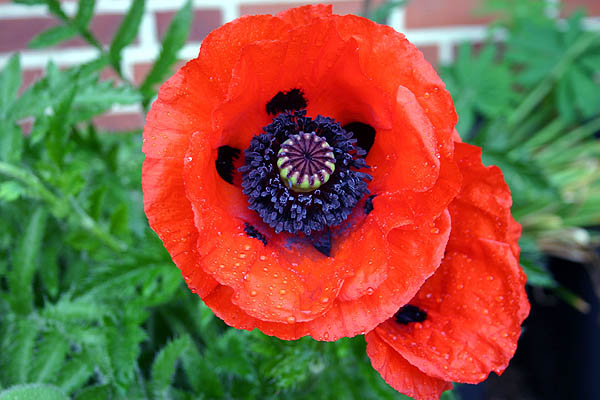Dramatic display of large red blooms on tall stout stems in early summer. This hardy perennial is a delight to every garden. Planted in full sun it will return year after year with a splendid display of flowers then die down and go dormant during the summer months to return in autumn and produce rosettes of green leaves that persist through winter. Once established Oriental poppies can last for decades and need little or no care except cutting down the foliage and enjoying the flowers. Hardy to zone 3 but does not like hot humid weather so not a plant for southeastern US. Wildlife don't eat it but pollinators and hummingbirds love the flowers.
Oriental poppies produce tap roots and are extremely fussy about having their roots disturbed so special care must be taken if starting seeds indoors to ensure roots are not disturbed during transplanting.
Poppy seeds are very small so they can become overrun with weeds if direct sown, if you are sure you can recognize the seedlings when the appear and not pull them out then direct seeding is a good option with this plant.
Poppy seed is fairly small so the best option is to use small peat or paper pots with a good light germination mix and scatter several seeds on the top of the moistened mixture then place in a light location or under grow lights. Tends to germinate in 21 days at temperatures of about 70 F (20 C). Will take longer at other temperatures.
If growing large numbers its possible to start in small individual cell trays and carefully transplant the small seedlings once roots are large enough to larger peat or paper pots. This ensures that plants have germinated and are doing well before they are placed in larger more space consuming pots. It does however run the risk of root disturbance and may stunt the plants growth to begin with. However since seedlings tend to be quite small when this process occurs seedlings are often resilient enough to overcome any changes at this stage. Do not attempt to do this once seedlings are larger (more than 2 inches (5 cm) tall) with strong root systems as it will stunt growth and set plants back considerably..
Keep area clear of weeds until plants begin to grow well. Familiarize yourself with what the seedlings look like so you don't accidently remove the poppy seedlings while weeding.
Once plants have grown they can be thinned to about 12-18 inches (30-46 cm) apart. Sadly the removed plants must be discarded as they wont transplant. Try not to disturb the roots of the remaining plants during this process. If plants are too close together use small scissors and cut those plants selected for removal to the ground. They rarely return if cut early enough. This ensure that the other plants are not disturbed.
Oriental poppies are a cool weather plant, they don't like really hot or humid conditions so they don't do well in zones lower than 7b. Due to their dislike of hot weather they will go dormant during the summer months and loose their foliage which will regrow in autumn once temperatures return so something they like.
They need full sun most of the day if you do grow in warmer zones then ensure they have shade from noon sunshine. While they don't like humid conditions it is possible to grow them in warmer areas that are dry but they will need shade once temperatures become really hot.
Too much shade makes them lanky and the flower stems tend to be too pliable so they bend over from the weight of the heavy flower heads. Thus is such locations they will need either staking or using plant cages of some kind.
Soil needs to be well draining and fairly neutral so if your soil is acidic add some lime to the area before planting and then add a little pelletized lime during the summer months when poppies go dormant. This many not occur in colder zones 3-4. Cannot tolerate wet soils it will rot the roots. Most plants do best with some good organic material in the soil and once established side dressed or mulched with additional material in subsequent years. Do not over feed as too much Nitrogen encourages leaf growth and makes flower stems more pliable so they bend over. Staking or flower cages would be required.
Water plants well in their first year, daily while still small but tapering off to every other day then weekly as they grow, depending on rainfall. Once established they need little extra water unless there is a drought. Then water bi weekly during growth and flowering stages. Once plants have gone dormant for summer no extra water is required.
Plants grow larger and more impressive with more flower stalks every subsequent year. Once flowering is complete the foliage dies back and the plant goes dormant for the summer then begins to grow more leaves during the fall which will overwinter even in cold zones giving good ground cover when most other plants have vanished. This is useful to help prevent soil erosion during the winter months which can happen with bare soils.
Deadheading does not increase bloom production so seed heads can either be left for decoration, harvested for dried flower displays or just cut down. Dead foliage can also be removed or just planted over. Do not remove new foliage that appears in autumn.
Poppies expect a cold winter, its part of their biology. If winters are mild the plant stems may not develop as strongly and grow as tall, sometimes they are only a few inches tall when blooming.
Suitable plants would be other perennials such as Garlic Chives which tend to come up later and bloom in fall when poppies are just returning. Birds foot trefoil makes a great ground cover with lovely yellow flowers or Sweet Alyssum a tough annual that thrives in hot dry areas will cover the ground while the poppies are dormant.
Seeds. Oriental poppies are not edible some suggest they may be poisonous. Culinary poppy seeds come from the Opium poppy. So don't try and eat these.








